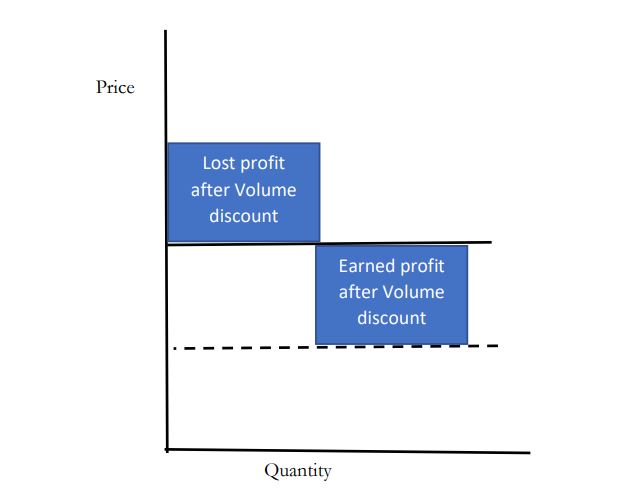Volume Discount Sensitivity Analysis for Optimal Pricing Strategies in B2B Firms
Keywords:
B2B, Sensitivity analysis, Volume hurdle, volume discountAbstract
Volume discounts are particularly prone to misinterpretation in the B2B sector. This is because corporate clients are more inclined to purchase things in large quantities. This research argues that when considering a volume discount, the first line of examination should be volume discount sensitivity analysis. We define volume sensitivity as how much a product's volume discount influences a customer's desire or readiness to purchase. It indicates the relative relevance of volume discount to other product features or buying factors for purchasers. We discussed how techniques such as the Ladder method, Van Westendorp method, and Gabor-Granger approach can assist the firms in devising optimal volume discount strategies. This research also discusses the volume hurdle analysis in the context of volume discounting. If a firm anticipates meeting the volume hurdle, a volume discount may be necessary. If the volume hurdle exceeds the predicted change in sales, the volume discount cannot be supported, and the company should adopt other options.
References
Akella, R., Araman, V. F. and Kleinknecht, J. (2002) ‘B2B Markets: Procuremen and supplier risk management in E-Business’, in Supply chain management: Models, applications, and research directions. Springer, pp. 33–66.
Auricchio, V. (2007) ‘Discount Policies in US and EU Antitrust Enforcement Models: Protecting Competition, Competitors or Consumer Welfare?’, European Competition Journal, 3(2), pp. 373–409.
Bakken, D. G. (2013) ‘Are you sure the price is right?(pricing and business strategy)’, Strategic Direction.
Banerjee, S. (2009) ‘Effect of product category on promotional choice: comparative study of discounts and freebies’, Management Research News.
Biemans, W. G., Brenčič, M. M. and Malshe, A. (2010) ‘Marketing–sales interface configurations in B2B firms’, Industrial Marketing Management, 39(2), pp. 183–194.
Bloom, J. Z. (2005) ‘Market segmentation: A neural network application’, Annals of Tourism Research, 32(1), pp. 93–111.
Bockhorn, M. and Harris, K. (1989) ‘Are cash discounts in the farm supply industry profitable?’, Agribusiness, 5(2), pp. 87–94.
Bussler, C. (2013) B2B Integration: Concepts and Architecture. Springer Berlin Heidelberg. Available at: https://books.google.com/books?id=r-qpCAAAQBAJ.
Cason, T. N., Friedman, D. and Milam, G. H. (2003) ‘Bargaining versus posted price competition in customer markets’, International Journal of Industrial Organization, 21(2), pp. 223–251.
Celnicker, A. and Seaman, B. (1989) ‘Functional Discounts, Trade Discounts, Economic Price Discrimination and the Robinson-Patman Act’, Utah L. Rev., p. 813.
Ceylana, H. H., Koseb, B. and Aydin, M. (2014) ‘Value based pricing: A research on service sector using Van Westendorp Price Sensitivity Scale’, Procedia-Social and Behavioral Sciences, 148, pp. 1–6.
Chhabra, S. (2015) ‘Determining the optimal price point: using Van Westendorp’s price sensitivity meter’, in Managing in recovering markets. Springer, pp. 257–270.
Chiu, C.-Y. et al. (2009) ‘An intelligent market segmentation system using k-means and particle swarm optimization’, Expert systems with applications, 36(3), pp. 4558–4565.
Das, C. and Tyagi, R. (1994) ‘Wholesaler: a decision support system for wholesale procurement and distribution’, International Journal of Physical Distribution & Logistics Management.
Deepak, R. K. A. and Jeyakumar, S. (2019) Marketing management. Educreation Publishing.
Dobbs, I. M. (2015) ‘Ladder Pricing – A New Form of Wholesale Price Discrimination’, https://doi.org/10.1080/13571516.2014.991558, 22(1), pp. 1–21. doi: 10.1080/13571516.2014.991558.
Durkin, S. (2016) ‘The competitive effects of loyalty discounts in a model of competition implied by the discount attribution test’, Antitrust LJ, 81, p. 475.
Eassie, R. W. F. (1979) ‘Buy‐response Analysis: A Practical Tool of Market Research’, European Journal of Marketing.
Emerson, P. M. (2019) Intermediate Microeconomics. Oregon State Open Educational Resources (Open textbook library). Available at: https://books.google.com.bd/books?id=F-dCzgEACAAJ.
Fatima, S. S., Wooldridge, M. J. and Jennings, N. R. (2006) ‘Multi-issue negotiation with deadlines’, Journal of Artificial Intelligence Research, 27, pp. 381–417.
Funk, D. C. (2002) ‘Consumer-based marketing: The use of micro-segmentation strategies for understanding sport consumption’, International Journal of Sports Marketing and Sponsorship.
Gibbs, M. J. et al. (2009) ‘Performance measure properties and incentive system design’, Industrial relations: a journal of economy and society, 48(2), pp. 237–264.
Grize, Y. L. (2015) ‘Applications of statistics in the field of general insurance: An overview’, International Statistical Review, 83(1), pp. 135–159. doi: 10.1111/INSR.12066.
Harrison, D. A. et al. (2002) ‘Time, teams, and task performance: Changing effects of surface-and deep-level diversity on group functioning’, Academy of management journal, 45(5), pp. 1029–1045.
Holden, R. K. (2012) Negotiating with Backbone: Eight Sales Strategies to Defend Your Price and Value. Pearson Education. Available at: https://books.google.com/books?id=8Y33SeZ-MUMC.
Iranmanesh, M., Jayaraman, K. and Ismail, I. (2014) ‘Intention to purchase products under volume discount scheme: a conceptual model and research propositions’, Business: Theory and Practice, 15(4), pp. 371–380.
Kawakatsu, H. (2011) ‘A Wholesaler’s Optimal Ordering and Quantity Discount Policies for Deteriorating Items.’, Engineering Letters, 19(4).
Keiser, T. C. (1988) Negotiating with a customer you can’t afford to lose. Harvard Business School.
Khan, M. A. et al. (2020) ‘The effect of advance payment with discount facility on supply decisions of deteriorating products whose demand is both price and stock dependent’, International Transactions in Operational Research, 27(3), pp. 1343–1367.
Krämer, A., Jung, M. and Burgartz, T. (2016) ‘A small step from price competition to price war: understanding causes, effects and possible countermeasures’, International Business Research, 9(3), pp. 1–13.
Kwon, O. et al. (2015) ‘The Informational Role of Product Trade‐Ins for Pricing Durable Goods’, The Journal of Industrial Economics, 63(4), pp. 736–762.
Lambrecht, A. et al. (2012) ‘Price discrimination in service industries’, Marketing Letters, 23(2), pp. 423–438.
Lázár, E., BUSINESS, E. L.-J. O. E. A. and 2010, undefined (no date) ‘Microeconometric models in market research price optimization’, researchgate.net. Available at: https://www.researchgate.net/profile/Dragos-Simandan/publication/288861853_Energy_space_and_society_A_reassessment_of_the_changing_landscape_of_energy_production_distribution_and_use/links/579d1d6408ae5d5e1e14c18f/Energy-space-and-society-A-reassessment-of-the-changing-landscape-of-energy-production-distribution-and-use.pdf#page=47
Lázár, E., Research, E. L.-J. of E. and B. and 2009, undefined (no date) ‘New methods in demand based price optimization’, academia.edu. Available at: https://www.academia.edu/download/30863963/JEBR_2009_2.pdf#page=43
Lekmat, L. (2002) ‘E-commerce technology for online Chai-ya Salty Egg’.
Lieberman, M. (2015) ‘Pricing research: A new take on the Van Westendorp model’, Quirk’s Marketing Research Review, 2, pp. 1–5.
Lipovetsky, S. (2006) ‘Van Westendorp price sensitivity in statistical modeling’, International Journal of Operations and Quantitative Management, 12(2), p. 141.
Lipovetsky, S., Magnan, S. and Zanetti-Polzi, A. (2011) ‘Pricing models in marketing research’.
Long, J. B. (1984) ‘Comments on" Gaussian Demand and Commodity Bundling"’, The Journal of Business, 57(1), pp. S235–S246.
Marn, M. V and Rosiello, R. L. (1992) ‘Managing price, gaining profit’, McKinsey Quarterly, p. 18.
Merchant, K. A. et al. (2011) ‘Performance measurement and incentive compensation: an empirical analysis and comparison of Chinese and Western firms’ practices’, European accounting review, 20(4), pp. 639–667.
Le Meunier‐FitzHugh, K. and Piercy, N. F. (2007) ‘Exploring collaboration between sales and marketing’, European Journal of Marketing.
Le Meunier‐FitzHugh, K. and Piercy, N. F. (2010) ‘Improving the relationship between sales and marketing’, European Business Review.
Mohammed, R. et al. (2004) ‘Internet marketing’, Auflage, New York.
Nicolau, J. L. and Más, F. J. (2006) ‘Micro segmentation by individual tastes on attributes of tourist destinations’, Tourism Management: New Research New York. Nova Science Publishers: New York, NY.
Parguel, B. et al. (2007) ‘Format effects in volume discounts to consumers’, Journal of Product & Brand Management.
Price, B. (2002) ‘Laddered questions and qualitative data research interviews’, Journal of advanced nursing, 37(3), pp. 273–281.
Reeder, J. (2014) ‘Nonlinear price incentives and dynamic brand choice: B2B purchasing decisions with quantity discounts’.
Rowley, J. (1997) ‘Principles of price and pricing policy for the information marketplace’, Library Review.
Sadrian, A. A. and Yoon, Y. S. (1992) ‘Business volume discount: A new perspective on discount pricing strategy’, International Journal of Purchasing and Materials Management, 28(2), pp. 43–46.
Salazar, J. M. R. (2017a) ‘Inverted u-shaped impact of social media posting frequency on engagement and sentiment ratio’, Empirical Quests for Management Essences, 1(1), pp. 1–15.
Salazar, J. M. R. (2017b) ‘Social media sites and teenage purchase intention in online shopping: an experimental study’, International Journal of Contemporary Financial Issues, 2(1), pp. 39–54.
Salazar, J. M. R. (2017c) ‘The Influence of Digital Marketing and social media On the Purchase Intentions of Small Business Food Products’, Journal of Modern Issues in Business Research, 5(2), pp. 50–57.
Salazar, J. M. R. (2018) ‘A Comparison of The Effectiveness of Various Social Media Platforms in Promoting Restaurants’, Empirical Quests for Management Essences, 2(4), pp. 1–14.
Siguaw, J. A., Kimes, S. E. and Gassenheimer, J. B. (2003) ‘B2B sales force productivity: applications of revenue management strategies to sales management’, Industrial Marketing Management, 32(7), pp. 539–551.
Sikarwar, N. S. and Verma, D. (2012) ‘Micro segmentation: today’s success formulae’, International Journal of Operations Management and Services, 2(1), pp. 1–6.
Sinha, S. K. and Verma, P. (2020) ‘Impact of sales promotion’s benefits on perceived value: does product category moderate the results?’, Journal of Retailing and Consumer Services, 52, p. 101887.
Smith, T. (2011) Pricing strategy: Setting price levels, managing price discounts and establishing price structures. Cengage Learning.
Sowter, A. P., Gabor, A. and Granger, C. W. J. (1971) ‘The effect of price on choice: a theoretical and empirical investigation’, Applied Economics, 3(3), pp. 167–181.
Stremersch, S. and Tellis, G. J. (2002) ‘Strategic bundling of products and prices: A new synthesis for marketing’, Journal of marketing, 66(1), pp. 55–72.
Sukumar, S. R. and Aline, F. (2013) ‘Application of micro-segmentation algorithms to the healthcare market: A case study’, in 2013 Biomedical Sciences and Engineering Conference (BSEC). IEEE, pp. 1–4.
Tom, W. K., Balto, D. A. and Averitt, N. W. (1999) ‘Anticompetitive aspects of market-share discounts and other incentives to exclusive dealing’, Antitrust LJ, 67, p. 615.
Wedel, M. and Leeflang, P. S. H. (1998) ‘A model for the effects of psychological pricing in Gabor–Granger price studies’, Journal of Economic Psychology, 19(2), pp. 237–260.
Weiner, J. L. (2001) ‘Applied Pricing Research’, in Sawtooth Software Conference. Citeseer, p. 111.
Widrick, S. M. (1985) ‘Quantity surcharge—quantity discount: pricing as it relates to quantity purchased’, Business & Society, 24(1), pp. 1–7.
Zhang, J. Z., Netzer, O. and Ansari, A. (2014) ‘Dynamic targeted pricing in B2B relationships’, Marketing Science, 33(3), pp. 317–337.

Downloads
Published
How to Cite
Issue
Section
License
Copyright (c) 2018 ResearchBerg

This work is licensed under a Creative Commons Attribution-NonCommercial-NoDerivatives 4.0 International License.
Creative Commons licenses are used to publish Open Access articles, which provide the legal basis for users to access, distribute, and reuse the content. EQME allows authors to apply one of the following Creative Commons licenses to their work, each of which affords readers distinct rights in terms of commercial use and the capacity to create derivative versions:
CC-BY (Creative Commons Attribution License)
CC-BY-NC-ND (Creative Commons Non-Commercial No Derivatives License)
CC-BY-NC-SA (Creative Commons Non-Commercial Share-a-like)
In each situation, the creator must be given credit, and if derivative versions of the work are created, the alterations must be noted.






